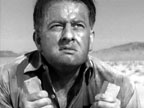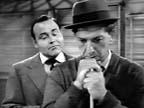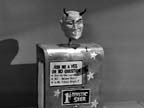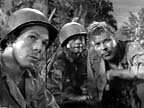Highlights From Another Twilight Zone Marathon
Every New Year's Eve, SyFy Channel unlocks a door with the key of imagination. Beyond it lies another dimension, one of sight and sound and of mind. If you don't have New Year's plans, or you've got a big enough DVR box, you can enter a land of both shadow and substance, of things and ideas. Every New Year's Eve, you can cross over into The Twilight Zone.
I'm an avowed The Twilight Zone fan — we've even done an IFC podcast on the series — and I particularly love watching the show in marathon form, dating back to my childhood when WPIX 11 in New York used to run them that way on holidays. Now the marathons are even better because you can save a whole bunch of episodes and pick and choose which ones you want to watch and in what order. Maybe you're in the mood to compare episodes where characters from various time periods interact. You can pair the enigmatic "A Hundred Yards Over the Rim," where a Western settler is mysteriously transported to the 1960s, with the haunting "A Stop at Willoughby," where a 1960s ad man on the verge of a nervous breakdown dreams of the simple small-town America of the 1880s). Or how about an evening of killer everyday objects? Batshit crazy aliens? A well-executed DVR marathon of The Twilight Zone is a lot like pimp Pierce Patchett's operation in L.A. Confidential: whatever you desire.
As I've done before, I've written up some of my thoughts on selections from this year's Twilight Zone marathon. I specifically avoided episodes I'd seen before, and wound up watching a dozen episodes, most of them solid to stellar. Here are my comments, in no particular order.

Name: Stopover in a Quiet Town
Episode Number: 150
Author: Earl Hamner, Jr.
Synopsis: A couple wakes from a night out partying to a bed they don't recognize, in a house they've never seen before, in a town that it totally deserted.
Theme(s): Don't Drink and Drive, Appearances Can Be Deceiving
Recurring Serling Motif: The fear of isolation. This episode is a variation on the plot from the very first Twilight Zone episode, "Where is Everybody?" in which an Air Force pilot finds himself alone in an empty town. In this case two people encounter the same scenario with essentially the same breakdown-inducing results. I've never read much on Serling himself, so I don't know if a fear of loneliness was something he dealt with but he and his staff certainly wrote about it in a profound way.
Best Bit: Bob and Millie Frasier (Barry Nelson and Nancy Malone) try to reassure themselves that they're not losing their minds by finding the one definitively real thing in the town: a good, solid tree. But when Bob knocks on it to prove its sturdiness, it topples over and reveals its flimsy, hollow base.
Why It Works: Though the episode is a retread of an idea done on the show earlier, and the acting by Nelson and Malone is nothing to write home about, this episode is bursting with chilling moments and clever social commentary. As the Frasiers desperately search for signs of life in the 'Quiet' town, they realize everything around them is a phony approximation of real life: plastic food in the refrigerator, cars with no motors under the hood. At one point they tear the false fronts off of some kitchen cabinets revealing the blank walls that lie underneath, a pithy critique of the emptiness beneath the sort of picture postcard surburban living portrayed in the episode. "Stopover"'s also one of those episodes that's fun to try to guess the twist of while you're watching it. The wife and I were batting our favorite theories back and forth throughout and the final revelation, which brilliantly explains the central conceit and the eerie child's laughter the Frasiers keep hearing around town but can't ever place to a source, wound up combining several of our favorite guesses into one clever solution.

Name: What's in the Box?
Episode Number: 144
Author: Martin Goldsmith
Synopsis: Joe, a grumpy taxi driver (William Demarest), watches in horror as his beloved television begins broadcasting scenes from his life.
Theme(s): The Scary Side of Mundane Objects, The Power of Fear
Recurring Serling Motif: Pitch black humor. This is about as dark a trip into the Twilight Zone as I've seen: husband and wife absolutely despise each other, fight, one kills the other, the end. And yet the entire episode is done completely tongue and cheek, and the mood is more jaunty than funereal. I love the escalating stakes as Joe keeps going back to the television, time and again, to see what's going to happen to his life. Now he's getting sentenced to death. Now he's getting strapped into the electric chair. We keep cutting back and forth from the images on the television to Demarest's terrified face, watching in sweaty, slack-jawed disbelief. Well, wouldn't you freak out?
Best Bit: Joe's television shows him scenes of a fight between him and his wife (Joan Blondell) that hasn't yet happened. As Joe looks on, his televisual self smashes a chair over his wife's back and then punches her right in the face, sending her careening out their apartment window and down to the pavement below.
Why It Works: You have to love Serling and writer Martin Goldswmith's willingness to eviscerate their own medium through the use of a story about a guy who is literally done in by his obsession with television. Joe turns on the television, sees images of himself on it, and freaks out. But instead of turning it off and leaving it off, he keeps turning it back on, to see what happens next. His addiction eventually leads him to see him murder his wife, and watching those events on television ultimately lead to him enacting them in real life. Note that the television doesn't order him to kill his wife. The addiction to the box is enough to make him do it on his own. If he'd just turned the television off, none of it would have happened.

Name: The After Hours
Episode Number: 34
Author: Rod Serling
Synopsis: A woman goes to a department store to buy a present for her mother and winds up on building's non-existent ninth floor.
Theme(s): Appearances Can Be Deceiving, The Scary Side of Mundane Objects
Recurring Serling Motif: "The After Hours" contains one of the most effective versions of a common Twilight Zone storyline: a sane person's swift descent into madness when no one around them believes something they feel with 100% certainty. Like William Shatner's character in "Nightmare at 20,000 Feet" who can't convince anyone else on his airplane that there's a creature on the wing, Anne Francis' character knows she bought a gold thimble on the store's ninth floor. When she goes to the complaint department, they insist she's mistaken. And when the woman she claims sold her the thimble reappears in a different form, it's more than her fragile psyche can handle.
Best Bit: After desperately trying to convince the department store staff that she really did go to the ninth floor, Marsha (Francis) spots the woman who'd sold her the thimble from across the crowded room. The woman turns around, and she is! (dramatic pause) one of the department store's mannequins!
Why It Works: Serling had an uncanny knack for finding the sinister in the everyday: slot machines, fortune tellers, cameras, television sets (see above). In this episode, it's department store mannequins. Waking from a fainting spell after the store has closed, she finds herself alone with the store's mannequins, some of whom resemble people she'd seen earlier in the day. Her unsettling journey through the empty store gives way to a montage of the mannequins and their grotesquely painted faces. If the ultimate explanation of Marsha's confusion — she's actually a mannequin who'd forgotten that she was given her one month of a vacation away from the store — doesn't make a whole lot of sense (so mannequins can come to life? How? And why do they submit to being a frozen, wooden human statue 11 months of the year?) Serling's final monologue makes clear the subtext that's far more important than the narrative:
"A wooden lady with a painted face who, one month out of the year, takes on the characteristics of someone as normal and as flesh and blood as you and I. But it makes you wonder, doesn't it? Just how normal are we? Just who are the people we nod our hellos to as we pass on the street?"

Name: The Grave
Episode Number: 72
Author: Montgomery Pittman
Synopsis: A hired gun visits the grave of the man he failed -- or was too afraid -- to kill.
Theme(s): The Power of Fear, The Morality of Killing, The Supernatural Existing as Function of Perception
Recurring Serling Motif: A lot of the pantheon Twilight Zone episodes feature clarifying twists, like the reveal in "The Eye of the Beholder" that the hideous face a woman has been trying to surgically alter is actually gorgeous, but a lot of the less well-known episodes, like this one, are far more enigmatic and sometimes, like this one, far more interesting. "The Grave"'s finale is less of an explanation than an insistence on ambiguity. But then this whole episode is about the nature of ambiguity: we can believe in the supernatural or we can believe it all a figment of an insane man's mind.
Best Bit: Conny Miller (Lee Marvin) plunges his knife into the grave of a dead man. He starts to stand up to leave when something unseen from below the frame pulls him back down.
Why It Works: Because of exceptional casting. This is a quiet, one-act play in a Western setting. The majority of its 22 minutes is a scene in a bar where Marvin's character is questioned by several townsfolk about his failure to kill an outlaw he'd been hired to hunt down. The outlaw claimed on his deathbed that the slower he ran the slower Miller chased, and the men in the bar who finally killed the outlaw when he returned to town wonder why they succeeded where a pro like Miller failed. Miller delivers stock denials, and grows enraged when he's accused of cowardice, but Lee Marvin's already exquisitely weathered face, his hunched, defeated posture, his excessive defensiveness, all hint at an unexplained truth that lies somewhere between the two poles.

Name: People Are Alike All Over
Episode Number: 25
Author: Rod Serling, based on a story by Paul W. Fairman
Synopsis: An astronaut travels to Mars, terrified of what life may be like on other planets.
Theme(s): The Power of Fear, Be Careful What You Wish For, If Aliens Exist, They Probably Are Just Gonna Kill Us All
Recurring Serling Motif: Sinister wordplay. Serling was as good as bringing twists to innocuous phrases as to stories. He had a knack for turning everyday language against its users, a trick that went hand-in-hand with another Serling hallmark: telling stories about the dangers of wish fulfillment. Think of "Time Enough at Last," where a nuclear holocaust gives poor Burgess Meredith time to enjoy all the books he desires just before his glasses break, robbing him of his ability to read. Here, astronaut Sam Conrad (Roddy McDowell) has a crippling fear of what alien life might be like. His co-pilot (Paul Comi) reassures him that whatever principles or powers have governed the evolution of man would be the same in every corner of the universe; thus, people are alike all over. This becomes Conrad's reassuring mantra. And when aliens who seemed so benevolent reveal their true, inhuman nature, the doomed Conrad realizes, with a pitiful sigh, that people are indeed alike all over.
Best Bit: The inhabitants of Mars welcome Conrad with open arms, even build an uncanny replica of an Earth house for him to live in. But after they leave him in it he realizes that all the doors are locked. And there are no windows. And then suddenly one wall panel splits and opens, revealing a gallery of onlookers standing behind a set of bars. Conrad realizes, as we do, that he has been put inside a zoo.
Why It Works: The Twilight Zone has a lot of episodes about aliens and the space race. Nearly all of them end badly for Earth. Serling seemingly had no use for the general excitement and curiosity about space travel at the time; on his show, these sorts of endeavors typically conclude with doom for the protagonists and for the whole of humanity. "People Are Alike All Over" is a very good episode, but its formula of paranoid visions of alien life and darkly comedic turns of phrase would be taken to even greater heights in the classic season three episode "To Serve Man." Not only are people alike all over, they enjoy a good human bisque.
Also watched, in order from phenomenal to feh: "A Stop at Willoughby," "A Hundred Yards Over the Rim," "Mr. Garrity and the Graves," "Black Leather Jackets," "Execution"
Labels: The Twilight Zone




